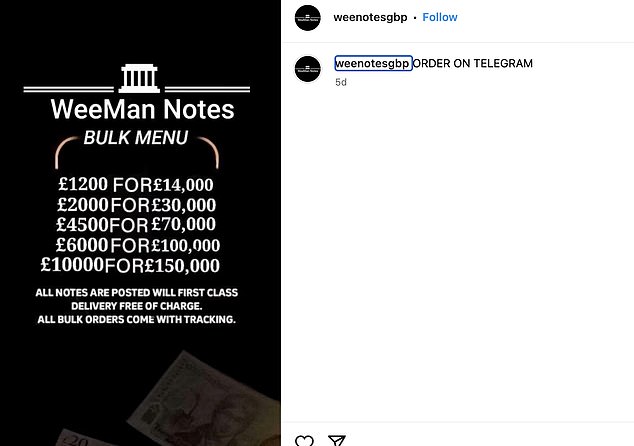Fraudsters are shamelessly promoting counterfeit banknotes on social media, currency firm warns
- Scammers sell counterfeit banknotes on social media sites
- Research by No1 Valuta shows that they pay to advertise online
- And there are concerns that the fraudsters are preying on the most vulnerable
Scammers are shamelessly promoting counterfeit notes on social media and even offering ‘bulk buy’ discounts on their fake money to the most vulnerable, a major currency firm has warned.
Social media sites, including Facebook, Instagram and
The adverts show stacks of £10 and £20 notes, as well as high denomination euro notes, claiming the counterfeit money is realistic enough to pass security checks.
Flash the fake money: Criminals use social media to sell counterfeit banknotes
Criminals are selling counterfeit banknotes online for a fraction of the face value of what real banknotes are worth, according to exclusive research for This is Money from No1 Valuta.
One criminal sold £14,000 worth of fake notes for £1,200, and £150,000 worth of fake money for £10,000.
This is Money’s own research shows that one criminal has been advertising stacks of “top quality polymer banknotes” on Facebook in recent weeks, while another has been posting since February.
According to the Bank of England, generally less than 1 in 40,000 banknotes were counterfeit by 2023.
However, research from travel money company No1 Valuta has found that some scammers are paying for sponsored posts that appear on the social media timelines of vulnerable people.
The cookies that record which websites you use help deliver the ads you see on social media, so those struggling to make ends meet are particularly likely to be targeted.
The company says those behind the ads are committing an offense, while those who are inattentive and part with their money to buy the counterfeit notes risk being scammed if their notes don’t arrive, or committing an offense themselves.

An Instagram account is offering ‘bulk buy’ discounts for counterfeit banknotes
Even if the notes do arrive, they are worthless and any store or bank that receives one is obliged to confiscate them and notify the authorities.
Simon Phillips, managing director of No1 Coin, said: “It is worrying to see organized criminals advertising so brazenly on social media.
‘Their slick advertisements offer a dangerous fantasy: the chance to buy supposedly realistic-looking banknotes for a fraction of their face value.
‘The reality is that modern banknotes are packed with security features – from holograms and precision printing to distinctive metal inserts set into the multi-layer polymer construction.
“The social media companies must do more to tackle such blatantly fraudulent activities. If criminals can pay to advertise their services so openly, it indicates that something is seriously wrong with the approval process at these tech giants.”
Technology companies are increasingly under scrutiny for the role they play in the way criminals target their victims.
Our sister title Money Mail has been campaigning for the government to force tech companies to step in and stop the scammers.
Last year we revealed a new recruitment scam circulating on WhatsApp and how Facebook Marketplace had become a hotbed of scammers.
While major tech companies including Meta, eBay, Google and Amazon have signed a voluntary ‘Online Fraud Charter’, scams are still rife online.
A spokesperson for Meta told This Is Money: ‘Fraudulent activity is not permitted on our platforms and we remove this content as soon as it is identified.
‘We are continually investing in new technologies to tackle this sector-wide problem and encourage people to report these types of activities to us and the police so that we can take action.’

